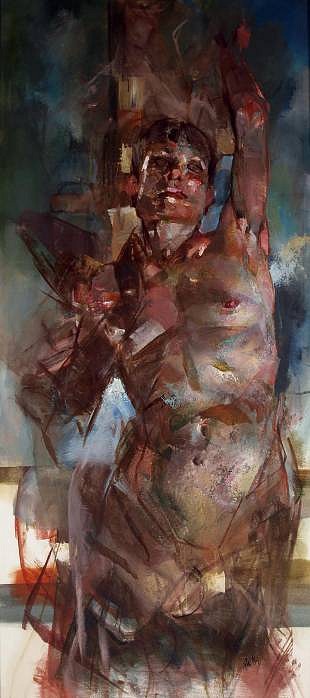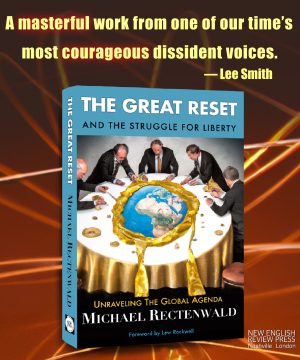By Guido Mina di Sospiro (November 2020)

Woman with Arm Raised, Peter Cox, 2011
Back in 1992 I sent a letter to my old Latin literature professor in which, inter alia, I translated for him the ending of a book I had finished a few months before, The Story of Yew, aka Memoirs of a Tree. There follows an excerpt from the professor’s epistolary reply:
The short fragment of your novel, which you transcribed for me, I liked very much. It contains a serious reflection that I believe is one of the main themes of the book. Nature, death: questions destined to remain without a convincing answer. Among the many answers we could choose the one from poetry books with their suffered ‘non omnis moriar.’ In truth man works, creates, not to die wholly, to survive at least in part in what he has done. There is in us an irrepressible yearning for the eternal. Try to reread or rethink the work of a poet taking as a key to understanding the theme of death, his answer to this mystery. And perhaps you will discover that literature was born as a function of death, as an answer to the mystery of death.
Non omis moriar is taken from what probably constitutes the oldest poetical testament: Horace’s Ode 3.30. It means, I will not wholly die. In rather bombastic fashion
I have created a monument more lasting than bronze
and loftier than the royal structure of the pyramids,
that which neither devouring rain, nor the unrestrained North Wind
may be able to destroy, nor the immeasurable
succession of years and the flight of time. (…)
the poet announces to his contemporaries and above all to posterity that he will not wholly die, that part of him will live on in his poetry, as, in fact, it has: here I am, in 2020, quoting a poem as old as the yew tree in my novel: two millennia.
Was my professor right? Is that why we write? Not to die wholly, to survive at least in part in what we have done? Was literature born, much as religion, as an answer to the mystery of death? I posed these questions to one of the most insightful literary critics I know, Davide Brullo, himself a poet. His reply:
Certainly, man writes to find the word that will resurrect him. But it is true that the answer to death is through life. Poetry is life, phenomenal, acrobatic. I believe, moreover, that there is an inheritance, a legacy in light. At any rate the battle with death is lost, so let’s hurl verbal fireballs at the face of the coming millennium, whether the name of the writer exists or not is unfair, vain. He creates a language.
Immortality, then, the true goal of alchemy, the eschatological objective of so many religions, major and minor: È bello doppo il morire vivere ancora, as the Renaissance motto goes: it’s beautiful, after having died, to be still alive.
I wonder if it was the same yearning for immortality that animated Alfred Jarry when he wrote Gestes et Opinions du Docteur Faustroll, Pataphysicien (Exploits and Opinions of Dr. Faustroll, Pataphysician)? Yes and no would be both appropriate answers. One of the cleverest and most mind-bending books known to me, predating developments in western culture by about eighty years, it was written in 1898 and first published posthumously in 1911, four years after Jarry’s death.
Was it the same yearning for immortality that informed Guido Morselli’s Dissipatio H.G.? The answer may well be, once more, both yes and no.
The title stands for Dissipatio Humani Generis, a sentence excerpted from the writings of Iamblichus; it means, the vanishing of humankind.
The narrating protagonist, a lucid, hypochondriac, “fobanthropic” more than misanthropic intellectual, decides to drown himself in a pond inside a cave high up in the mountains. But once there, he changes his mind, and walks back to his cottage.
He will eventually discover that humankind, after he changed his mind about committing suicide, has vanished. Humanity is now represented by its single remaining component, a man who was about to leave it behind and who never felt that he belonged in it in the first place.
Thus begins a monologue—philosophical, ontological and eschatological—with nothing but absolute silence as a background, except for a few noises caused by animals or by machines that keep on working. Soon his monologue turns into a dialogue, with his memories and then with all the vanished people.
The ultimate solipsist ends up longing desperately for humans.
This was Morselli’s last book. Unlike the protagonist in Dissipatio H.G., he did not change his mind at the last moment and did commit suicide shortly after this manuscript, too, was rejected.
But then it was published posthumously, along with several other books of his; its first English edition will be released in the US this coming December; and here I am, writing about it decades after its rejection prompted the author to take his own life—but he did not wholly die.
A few days ago I received through my website an e-mail from a fan. She had bought my Memoirs of a Tree in Lausanne, Switzerland, in its French edition, and had loved it; she had then bought it in its Spanish edition so that her husband could read it; and now, in Quito, Ecuador, she was going to present it to her book club, outdoors because of Covid restrictions, under the Pichincha Volcano—the same book with which I opened this meditation and whose ending I translated, back in the early 1990s, for my professor of Latin literature. What strikes me in retrospect is that the yew tree (Taxus baccata) is a technically immortal being, capable of regenerating itself in perpetuity. Its earliest fossils date back to two hundred and fifty million years ago and, compared to its present state, show that there has been no evolution: born perfect to live eternally.
How did this purported yearning for immortality resonate in me more or less half a lifetime ago? Perhaps not as consciously as it does now, but I suppose it was, even then, the motivator.
So many poets and writers did not wholly die, and their living legacy informs us to this day. Contemporary authors could think of them as their manes, i.e., the souls of dead ancestors, and worship them as benevolent spirits. Some of us probably already do.
«Previous Article Home Page Next Article»
__________________________________
Guido Mina di Sospiro was born in Buenos Aires, Argentina, into an ancient Italian family. He was raised in Milan, Italy and was educated at the University of Pavia as well as the USC School of Cinema-Television, now known as USC School of Cinematic Arts. He has been living in the United States since the 1980s, currently near Washington, D.C. He is the author of several books including, The Story of Yew, The Forbidden Book, The Metaphysics of Ping Pong, and Forbidden Fruits.
Follow NER on Twitter @NERIconoclast
- Like
- Digg
- Del
- Tumblr
- VKontakte
- Buffer
- Love This
- Odnoklassniki
- Meneame
- Blogger
- Amazon
- Yahoo Mail
- Gmail
- AOL
- Newsvine
- HackerNews
- Evernote
- MySpace
- Mail.ru
- Viadeo
- Line
- Comments
- Yummly
- SMS
- Viber
- Telegram
- Subscribe
- Skype
- Facebook Messenger
- Kakao
- LiveJournal
- Yammer
- Edgar
- Fintel
- Mix
- Instapaper
- Copy Link








